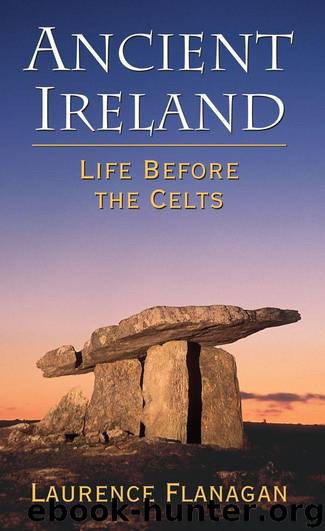Ancient Ireland: Life Before the Celts by Flanagan Laurence

Author:Flanagan, Laurence [Flanagan, Laurence]
Language: eng
Format: azw3
Publisher: Gill Books
Published: 1998-10-28T16:00:00+00:00
9.1Excavated and ‘investigated’ court tombs: the distribution of human evidence: (1) no bone; (2) bone unidentified; (3) bone partly identified; (4) unburnt bone
The fact that no bone was discovered in so many sites is almost certainly due to the fact that the local soil was so acid as to prevent its preservation even had it been cremated. The dearth of information from such a number of sites that did produce bone may be due to a number of reasons: it could be that the bone was present in such small quantity that it could not be meaningfully identified, or that it was so decayed that the result was the same, or even that no expert was conveniently available to undertake the examination. On some of the sites where there is information about the remains it is scanty enough: at Clontygora Large, County Armagh, for example, the cremated bone was of one adult, while at Carrick East, County Derry, the one chip of cremated bone found was identified as simply being from one adult. In some cases the identifications have been fairly informative—always, it must be remembered, minimal, depending very strongly on the preservation of particularly diagnostic pieces of bone. At Ballyreagh, County Fermanagh, a woman aged between twenty-five and thirty-five was identified, while at Aghnaskeagh, County Louth, a woman and a girl were identified from the cremated bone.
On some sites where there was unburnt bone, much more information was recovered. At Audleystown, County Down, some 33 people were represented, including the unburnt remains of 4 women, 6 men, 4 adults whose sex was not determined, and 5 children—in addition to the cremated remains of 11 other people.
The total number of bodies so far identified from excavated and ‘investigated’ court tombs amounts to some 44 or 45 unburnt and some 52 cremated. This total of less than a hundred cannot possibly constitute more than a gentle indication that there were people living and dying in the period of the court tombs who, for some reason, were accorded burial according to one rite or the other in the court tombs that have so far been excavated or ‘investigated’. The advantage—so far unexploited—of the presence of a reasonable proportion of unburnt skeletal material is that it represents a potential source of DNA, so that from the twenty-one or twenty-two individuals at Audleystown it could presumably be established whether any of the five children were related to the adult men or women also present.
There is, however, a rather devious method of calculating what might be described as a ‘maximum postulable population’. Audleystown is the most productive excavated site with some bodies represented. The two burial galleries were each divided into four chambers, but the burials were not evenly divided between the chambers. One of the chambers—number 2 in the western gallery—does, however, contain the greatest number of occupants per chamber of any excavated or ‘investigated’ court tomb, with a total of thirteen or upwards; this chamber is followed by chamber 1 in the eastern
Download
This site does not store any files on its server. We only index and link to content provided by other sites. Please contact the content providers to delete copyright contents if any and email us, we'll remove relevant links or contents immediately.
The Daily Stoic by Holiday Ryan & Hanselman Stephen(3196)
The Fate of Rome: Climate, Disease, and the End of an Empire (The Princeton History of the Ancient World) by Kyle Harper(2975)
People of the Earth: An Introduction to World Prehistory by Dr. Brian Fagan & Nadia Durrani(2673)
Ancient Worlds by Michael Scott(2579)
Babylon's Ark by Lawrence Anthony(2489)
The Daily Stoic by Ryan Holiday & Stephen Hanselman(2424)
Foreign Devils on the Silk Road: The Search for the Lost Treasures of Central Asia by Peter Hopkirk(2407)
India's Ancient Past by R.S. Sharma(2367)
MOSES THE EGYPTIAN by Jan Assmann(2347)
The Complete Dead Sea Scrolls in English (7th Edition) (Penguin Classics) by Geza Vermes(2204)
Lost Technologies of Ancient Egypt by Christopher Dunn(2173)
The Earth Chronicles Handbook by Zecharia Sitchin(2149)
24 Hours in Ancient Rome by Philip Matyszak(2025)
Alexander the Great by Philip Freeman(2009)
Aztec by Gary Jennings(1931)
The Nine Waves of Creation by Carl Johan Calleman(1841)
Curse Tablets and Binding Spells from the Ancient World by Gager John G.;(1819)
Before Atlantis by Frank Joseph(1787)
Earthmare: The Lost Book of Wars by Cergat(1763)
